Making Full Use of Qualitative Data to Generate New Fish Product Ideas through Co-Creation with Consumers: A Methodological Approach
Abstract
:1. Introduction
2. Materials and Methods
2.1. Participants’ Recruitment
2.2. Focus Group Sessions
- A warm-up debate about new foods and fish products.
- A creative approach by applying direct analogies (also known as analogical thinking) [37] and storyboarding [14] to engage participants in generating new product ideas. Additionally, a reverse thinking task (also known as reverse brainstorming, tear-down, or purge) [38] was included to determine which characteristics of the ideas previously elicited would be rejected by the rest of the consumers.
- A section where participants scored their acceptance of each new product idea elicited in the creative phase on a scale from 1 (“I very much dislike this fish product idea”) to 10 (“I like this fish product idea”).
- Finally, a general discussion section about fish and fish products to gain a deeper understanding of people’s practices regarding their purchase and consumption, opinions, interests, motivations, barriers, and behaviour with regard to new products.
2.3. Transcript Preparation: Data Preparation
2.4. Data Analysis
2.4.1. Part 1: Dimensions’ Identification and Their Frequencies
- Words with a common root (e.g., try, tried, and trying) were grouped under the same label (e.g., “try”).
- Filler words, meaningless words, or sounds that consumers use while talking to fill in the pauses (e.g., basically, just, well) were removed after context checking.
- Some words were grouped after checking their context in semantic (i.e., a set of words with related meanings) and associative semantic fields (i.e., similar to semantic fields but more subjective associations) to retain the information contained in the less frequently mentioned words.
- Antonym words were grouped because they were considered to be extremes of the same scale (e.g., the “easy” label grouped the words easy, ease, difficult, and complicated).
- Finally, homograph words, those with the same spelling but different meanings, were merged into their corresponding groups according to their meanings after context checking.
2.4.2. Part 2: Dimensions’ Importance
2.4.3. Part 3: Dimensions’ Importance versus Dimensions’ Frequency
3. Results
3.1. Part 1: Dimensions’ Identification and Their Frequencies
3.2. Part 2: Dimensions’ Importance
3.3. Part 3: Dimensions’ Importance versus Dimensions’ Frequency
4. Discussion
4.1. Dimensions’ Identification and Their Frequencies
4.2. Idea Generation and Dimensions’ Importance
4.3. Dimensions’ Importance versus Dimensions’ Frequency
4.4. Limitations and Suggestions for Future Research
5. Conclusions
Author Contributions
Funding
Institutional Review Board Statement
Informed Consent Statement
Data Availability Statement
Acknowledgments
Conflicts of Interest
Appendix A
| Ranking | New Product Idea | Total Score 1 | Average Score 2 | SD 3 |
|---|---|---|---|---|
| 1 | Fish brochettes for grilling, heathy appetizers | 46.0 | 7.7 | 1.0 |
| 2 | Aquaculture fish without additives, without chemicals | 44.0 | 7.3 | 1.8 |
| 3 | Salad with fish for self-service | 43.5 | 7.0 | 1.9 |
| 4 | Fish salad with biodegradable packaging, scannable to know the ingredients | 42.0 | 6.7 | 2.3 |
| 5 | Fishballs for snacking/appetizer | 42.0 | 6.5 | 2.2 |
| 6 | Mousse to spread on bread | 42.0 | 6.3 | 3.0 |
| 7 | Fish cooked with Reunion Island flavours and tastes | 41.5 | 6.0 | 1.6 |
| 8 | Box for snacking with assorted fishes | 40.0 | 6.0 | 2.3 |
| 9 | Ready sauce with fish | 40.0 | 5.2 | 2.7 |
| 10 | Fish mousse without bones, with dill, only fish | 39.0 | 4.2 | 2.4 |
| 11 | Frozen or chilled dishes, gourmet, designed by chefs | 39.0 | 6.5 | 2.7 |
| 12 | Fish dish with innovative sauce and fish-shaped packaging | 38.5 | 6.4 | 2.8 |
| 13 | Fish cooked in a natural way | 38.0 | 6.3 | 2.3 |
| 14 | Fish carpaccio | 36.0 | 6.0 | 2.5 |
| 15 | Uncommon fish species crumbed and of high quality | 36.0 | 6.0 | 2.3 |
| Ranking | New Product Idea | Total Score 1 | Average Score 2 | SD 3 |
|---|---|---|---|---|
| 1 | New packaging for frozen fish (e.g., bag instead of using foil) | 55.0 | 9.2 | 1.0 |
| 2 | Recyclable packaging (second use) | 52.0 | 8.7 | 2.0 |
| 3 | High-grade convenience products, local, quick | 51.0 | 8.5 | 2.1 |
| 4 | Avoiding problems (e.g., storage life, no shell, no fishbone, etc.) | 47.0 | 7.8 | 2.2 |
| 5 | Product with healthy ingredients (e.g., for crumb coating) like protein bars | 46.0 | 7.7 | 2.7 |
| 6 | Combination of different fish tastes and textures | 45.0 | 7.5 | 1.8 |
| 7 | New fish convenience products | 44.0 | 7.3 | 2.5 |
| 8 | A whole fish (fillable, already filleted, etc.) | 44.0 | 7.3 | 2.4 |
| 9 | No-waste burger | 44.0 | 7.3 | 2.5 |
| 10 | Packaging not made of plastic or aluminium | 41.0 | 6.8 | 3.9 |
| 11 | Fish with more power/enriched/all necessary ingredients contained | 37.0 | 6.2 | 3.3 |
| 12 | Product containing only fish, no other animal products | 36.0 | 6.0 | 3.5 |
| 13 | Canned fish with new supplements (e.g., lentils) | 35.0 | 5.8 | 2.6 |
| 14 | Fish-to-go (patty for burger, etc.), for microwave | 35.0 | 5.8 | 2.4 |
| 15 | Fish that does not taste fishy | 32.0 | 5.3 | 2.4 |
| Ranking | New Product Idea | Total Score 1 | Average Score 2 | SD 3 |
|---|---|---|---|---|
| 1 | With flavours, to mix with a small sauce bag (fine herbs, olive oil, pepper, mustard, garlic, and lemon) | 57.0 | 9.5 | 0.8 |
| 2 | Seabass, seabream, meagre in dices or crumbs, frozen, and boneless | 56.0 | 9.3 | 1.2 |
| 3 | Fish hamburgers | 51.0 | 8.5 | 1.4 |
| 4 | Tasty and boneless fish products | 50.0 | 8.3 | 1.2 |
| 5 | Coloured spaghetti surimi to decorate and add flavour | 49.0 | 8.2 | 2.8 |
| 6 | Fish tray (such as cheese tray), two fish species in the same tray, fresh | 49.0 | 8.2 | 1.2 |
| 7 | Fillets, cubes, smoked, in brine | 49.0 | 8.2 | 1.2 |
| 8 | Seabass fillets | 48.0 | 8.0 | 2.0 |
| 9 | New formats for children (stars, trapezoids, triangles) | 48.0 | 8.0 | 2.5 |
| 10 | Sushi with nice flavours | 47.0 | 7.8 | 1.9 |
| 11 | Fish with sauce preparation, tasty, high quality | 47.0 | 7.8 | 1.7 |
| 12 | Fish with flavour of other things (e.g., octopus + cooked potato, anchovies + chip potato) | 44.0 | 7.3 | 3.3 |
| 13 | Fish products with an extra healthy component | 44.0 | 7.3 | 1.2 |
| 14 | Small fish pieces with intense flavour | 39.0 | 6.5 | 2.4 |
| 15 | Different fish assortment, shellfish, different tastes | 36.0 | 6.0 | 2.2 |
References
- Melgarejo, R.; Malek, K. Setting the Record Straight on Innovation Failure; Nielsen: New York, NY, USA, 2018. [Google Scholar]
- Moon, H.; Johnson, J.L.; Mariadoss, B.J.; Cullen, J.B. Supplier and customer involvement in new product development stages: Implications for new product innovation outcomes. Int. J. Innov. Technol. Manag. 2018, 15, 1850004. [Google Scholar] [CrossRef]
- van Kleef, E.; van Trijp, H.C.M.; Luning, P. Consumer research in the early stages of new product development: A critical review of methods and techniques. Food Qual. Prefer. 2005, 16, 181–201. [Google Scholar] [CrossRef]
- Chang, W. The joint effects of customer participation in various new product development stages. Eur. Manag. J. 2019, 37, 259–268. [Google Scholar] [CrossRef]
- Prahalad, C.K.; Ramaswamy, V. Co-creation experiences: The next practice in value creation. J. Interact. Mark. 2004, 18, 5–14. [Google Scholar] [CrossRef] [Green Version]
- Galvagno, M.; Dalli, D. Theory of value co-creation: A systematic literature review. Manag. Serv. Qual. 2014, 24, 643–683. [Google Scholar] [CrossRef]
- Hoyer, W.D.; Chandy, R.; Dorotic, M.; Krafft, M.; Singh, S.S. Consumer cocreation in new product development. J. Serv. Res. 2010, 13, 283–296. [Google Scholar] [CrossRef]
- Witell, L.; Kristensson, P.; Gustafsson, A.; Löfgren, M. Idea generation: Customer co-creation versus traditional market research techniques. J. Serv. Manag. 2011, 22, 140–159. [Google Scholar] [CrossRef] [Green Version]
- Hsieh, L.-F.; Chen, S.K. Incorporating voice of the consumer: Does it really work? Ind. Manag. Data Syst. 2005, 15, 769–785. [Google Scholar] [CrossRef]
- Potts, J.; Hartley, J.; Banks, J.; Burgess, J.; Cobcroft, R.; Cunningham, S.; Montgomery, L. Consumer co-creation and situated creativity. Ind. Innov. 2008, 15, 459–474. [Google Scholar] [CrossRef] [Green Version]
- Kristensson, P.; Gustafsson, A.; Archer, T. Harnessing the creative potential among users. J. Prod. Innov. Manag. 2004, 21, 4–14. [Google Scholar] [CrossRef]
- Garfield, M.J.; Taylor, N.J.; Dennis, A.R.; Satzinger, J.W. Research report: Modifying paradigms—Individual differences, creativity techniques, and exposure to ideas in group idea generation. Inf. Syst. Res. 2001, 12, 322–333. [Google Scholar] [CrossRef] [Green Version]
- Donoghue, S. Projective techniques in consumer research. J. Fam. Ecol. Consum. Sci. 2000, 28, 47–53. [Google Scholar] [CrossRef]
- Banović, M.; Krystallis, A.; Guerrero, L.; Reinders, M.J. Consumers as co-creators of new product ideas: An application of projective and creative research techniques. Food Res. Int. 2016, 87, 211–223. [Google Scholar] [CrossRef] [PubMed]
- Earle, M.; Earle, R. (Eds.) New product development: Systematic industrial technology. In Case Studies in Food Product Development; CRC Press: Boca Raton, FL, USA, 2008. [Google Scholar]
- Guerrero, L.; Xicola, J. New approaches to focus groups. In Methods in Consumer Research, Volume 1: New Approaches to Classic Methods; Ares, G., Varela, P., Eds.; Woodhead Publishing: Duxford, UK, 2018; Volume 1, pp. 261–296. [Google Scholar]
- Stewart, D.; Shamdasani, P.; Rook, D. Analyzing focus group data. In Focus Groups: Theory and Practice; SAGE Publications: Thousand Oaks, CA, USA, 2007; pp. 109–133. [Google Scholar]
- Guerrero, L.; Claret, A.; Verbeke, W.; Enderli, G.; Zakowska-Biemans, S.; Vanhonacker, F.; Issanchou, S.; Sajdakowska, M.; Granli, B.S.; Scalvedi, L.; et al. Perception of traditional food products in six European regions using free word association. Food Qual. Prefer. 2010, 21, 225–233. [Google Scholar] [CrossRef]
- Denzin, N.K. The Research Act: A Theoretical Introduction to Sociological Methods; Routledge: New York, NY, USA, 2017. [Google Scholar]
- Pokorny, J.J.; Norman, A.; Zanesco, A.P.; Bauer-Wu, S.; Sahdra, B.K.; Saron, C.D. Network analysis for the visualization and analysis of qualitative data. Psychol. Methods 2018, 23, 169–183. [Google Scholar] [CrossRef]
- García, J.A.; Rodriguez-Sánchez, R.; Fdez-Valdivia, J. Authors and reviewers who suffer from confirmatory bias. Scientometrics 2016, 109, 1377–1395. [Google Scholar] [CrossRef]
- Guerrero, L.; Guàrdia, M.D.; Xicola, J.; Verbeke, W.; Vanhonacker, F.; Zakowska-Biemans, S.; Sajdakowska, M.; Sulmont-Rossé, C.; Issanchou, S.; Contel, M.; et al. Consumer-driven definition of traditional food products and innovation in traditional foods. A qualitative cross-cultural study. Appetite 2009, 52, 345–354. [Google Scholar] [CrossRef] [PubMed]
- Symmank, C. Extrinsic and intrinsic food product attributes in consumer and sensory research: Literature review and quantification of the findings. Manag. Rev. Q. 2019, 69, 39–74. [Google Scholar] [CrossRef]
- Illia, L.; Sonpar, K.; Bauer, M.W. Applying co-occurrence text analysis with ALCESTE to studies of impression management. Br. J. Manag. 2012, 25, 352–372. [Google Scholar] [CrossRef] [Green Version]
- Deng, S.; Xia, S. Mapping the interdisciplinarity in information behavior research: A quantitative study using diversity measure and co-occurrence analysis. Scientometrics 2020, 124, 489–513. [Google Scholar] [CrossRef]
- Puerta, P.; Laguna, L.; Vidal, L.; Ares, G.; Fiszman, S.; Tárrega, A. Co-occurrence networks of Twitter content after manual or automatic processing. A case-study on “gluten-free”. Food Qual. Prefer. 2020, 86, 103993. [Google Scholar] [CrossRef]
- Ares, G.; Deliza, R. Studying the influence of package shape and colour on consumer expectations of milk desserts using word association and conjoint analysis. Food Qual. Prefer. 2010, 21, 930–937. [Google Scholar] [CrossRef]
- Ares, G.; de Saldamando, L.; Giménez, A.; Claret, A.; Cunha, L.M.; Guerrero, L.; de Moura, A.P.; Oliveira, D.C.R.; Symoneaux, R.; Deliza, R. Consumers’ associations with wellbeing in a food-related context: A cross-cultural study. Food Qual. Prefer. 2015, 40, 304–315. [Google Scholar] [CrossRef]
- Melendrez-Ruiz, J.; Claret, A.; Chambaron, S.; Arvisenet, G.; Guerrero, L. Enhancing assessment of social representations by comparing groups with different cultural and demographic characteristics: A case study on pulses. Food Qual. Prefer. 2021, 92, 104188. [Google Scholar] [CrossRef]
- Polizer Rocha, Y.J.; Lapa-Guimarães, J.; de Noronha, R.L.F.; Trindade, M.A. Evaluation of consumers’ perception regarding frankfurter sausages with different healthiness attributes. J. Sens. Stud. 2018, 33, e12468. [Google Scholar] [CrossRef]
- Hsieh, H.F.; Shannon, S.E. Three approaches to qualitative content analysis. Qual. Health Res. 2005, 15, 1277–1288. [Google Scholar] [CrossRef]
- Vidal, L.; Ares, G.; Machín, L.; Jaeger, S.R. Using Twitter data for food-related consumer research: A case study on “what people say when tweeting about different eating situations”. Food Qual. Prefer. 2015, 45, 58–69. [Google Scholar] [CrossRef]
- Guiné, R.P.F.; Florença, S.G.; Barroca, M.J.; Anjos, O. The link between the consumer and the innovations in food product development. Foods 2020, 9, 1317. [Google Scholar] [CrossRef] [PubMed]
- Mintel. Global New Products Database (GNPD). Available online: https://www.gnpd.com/sinatra/search_results/?search_id=Fvf0PuANFb&page=0 (accessed on 2 December 2021).
- EUMOFA. The EU Fish Market; European Commission: Luxembourg, 2021. [Google Scholar]
- European Commission. Special Eurobarometer 515: EU Consumer Habits Regarding Fishery and Aquaculture Products; Maritime Affairs and Fisheries: Brussels, Belgium, 2021. [Google Scholar]
- Dahl, D.W.; Moreau, P. The influence and value of analogical thinking during new product ideation. J. Mark. Res. 2002, 39, 47–60. [Google Scholar] [CrossRef]
- Souder, W.E.; Zeigler, R.W. Review of creativity and problem solving techniques. Res. Manag. 1977, 20, 34–42. [Google Scholar] [CrossRef]
- Vidal, L.; Ares, G.; Giménez, A. Projective techniques to uncover consumer perception: Application of three methodologies to ready-to-eat salads. Food Qual. Prefer. 2013, 28, 1–7. [Google Scholar] [CrossRef]
- Gartzia, I.; Peral, I.; Alfaro, B.; Riesco, S.; Cruz, E.S.; Krystallis, A.; Brunsø, K.; Stancu, V.; Claret, A.; Guerrero, L. Deliverable D5.1: Identification of Product and Market Requirements of Aquaculture Chain Stakeholders; MedAID Project: Derio, Spain, 2018. [Google Scholar]
- Dalud-Vincent, M. Trial and critique of Alceste as a tool for analyzing semi-structured interviews in sociology. Lang. Société 2011, 135, 9–28. [Google Scholar] [CrossRef]
- IMAGE. Préparation du Corpus. Available online: https://www.image-zafar.com/images/formatage_alceste.pdf (accessed on 21 November 2021).
- Bazeley, P. Qualitative Data Analysis: Practical Strategies; SAGE Publications: London, UK, 2013. [Google Scholar]
- Onwezen, M.C.; Reinders, M.J.; Verain, M.C.D.; Snoek, H.M. The development of a single-item Food Choice Questionnaire. Food Qual. Prefer. 2019, 71, 34–45. [Google Scholar] [CrossRef] [Green Version]
- Steptoe, A.; Pollard, T.M.; Wardle, J. Development of a measure of the motives underlying the selection of food: The Food Choice Questionnaire. Appetite 1995, 25, 267–284. [Google Scholar] [CrossRef] [PubMed] [Green Version]
- Carroll, J.D. Individual differences and multidimensional scaling. In Multidimensional Scaling: Theory and Applications in the Behavioral Sciences; Shepard, R.N., Romney, A.K., Nerlove, S.B., Eds.; Seminar Press: New York, NY, USA, 1972; Volume 1, pp. 105–155. [Google Scholar]
- Robert, P.; Escoufier, Y. A unifying tool for linear multivariate statistical methods: The RV- coefficient. Appl. Stat. 1976, 25, 257. [Google Scholar] [CrossRef]
- Claret, A.; Guerrero, L.; Aguirre, E.; Rincón, L.; Hernández, M.D.; Martínez, I.; Peleteiro, J.B.; Grau, A.; Rodríguez-Rodríguez, C. Consumer preferences for sea fish using conjoint analysis: Exploratory study of the importance of country of origin, obtaining method, storage conditions and purchasing price. Food Qual. Prefer. 2012, 26, 259–266. [Google Scholar] [CrossRef]
- Conte, F.; Passantino, A.; Longo, S.; Voslářová, E. Consumers’ attitude towards fish meat. Ital. J. Food Saf. 2014, 3, 178–181. [Google Scholar] [CrossRef] [Green Version]
- Pieniak, Z.; Verbeke, W.; Scholderer, J. Health-related beliefs and consumer knowledge as determinants of fish consumption. J. Hum. Nutr. Diet. 2010, 23, 480–488. [Google Scholar] [CrossRef]
- McConnell, J.D. The price-quality relationship in an experimental setting. J. Mark. Res. 1968, 5, 300. [Google Scholar] [CrossRef]
- Kole, A.P.W.; Altintzoglou, T.; Schelvis-Smit, R.A.A.M.; Luten, J.B. The effects of different types of product information on the consumer product evaluation for fresh cod in real life settings. Food Qual. Prefer. 2009, 20, 187–194. [Google Scholar] [CrossRef]
- Claret, A.; Guerrero, L.; Ginés, R.; Grau, A.; Hernández, M.D.; Aguirre, E.; Peleteiro, J.B.; Fernández-Pato, C.; Rodríguez-Rodríguez, C. Consumer beliefs regarding farmed versus wild fish. Appetite 2014, 79, 25–31. [Google Scholar] [CrossRef] [PubMed]
- de Andrade, J.C.; de Aguiar Sobral, L.; Ares, G.; Deliza, R. Understanding consumers’ perception of lamb meat using free word association. Meat Sci. 2016, 117, 68–74. [Google Scholar] [CrossRef] [PubMed]
- European Commission. Facts and Figures on the Common Fisheries Policy: Basic Statistical Data; European Union: Luxembourg, 2020. [Google Scholar]
- Fishbein, M.; Ajzen, I. Predicting and Changing Behavior: The Reasoned Action Approach; Taylor & Francis: New York, NY, USA, 2011. [Google Scholar]
- Bleiel, J. Functional foods from the perspective of the consumer: How to make it a success? Int. Dairy J. 2010, 20, 303–306. [Google Scholar] [CrossRef]
- Klincewicz, K.; Dębska, K. Limits of co-creation: Evidence from a large-scale empirical study of food consumers. In Proceedings of the ESA Conference, Barcelona, Spain, 31 August–3 September 2021. [Google Scholar]
- Guerrero, L.; Colomer, Y.; Guàrdia, M.D.; Xicola, J.; Clotet, R. Consumer attitude towards store brands. Food Qual. Prefer. 2000, 11, 387–395. [Google Scholar] [CrossRef]
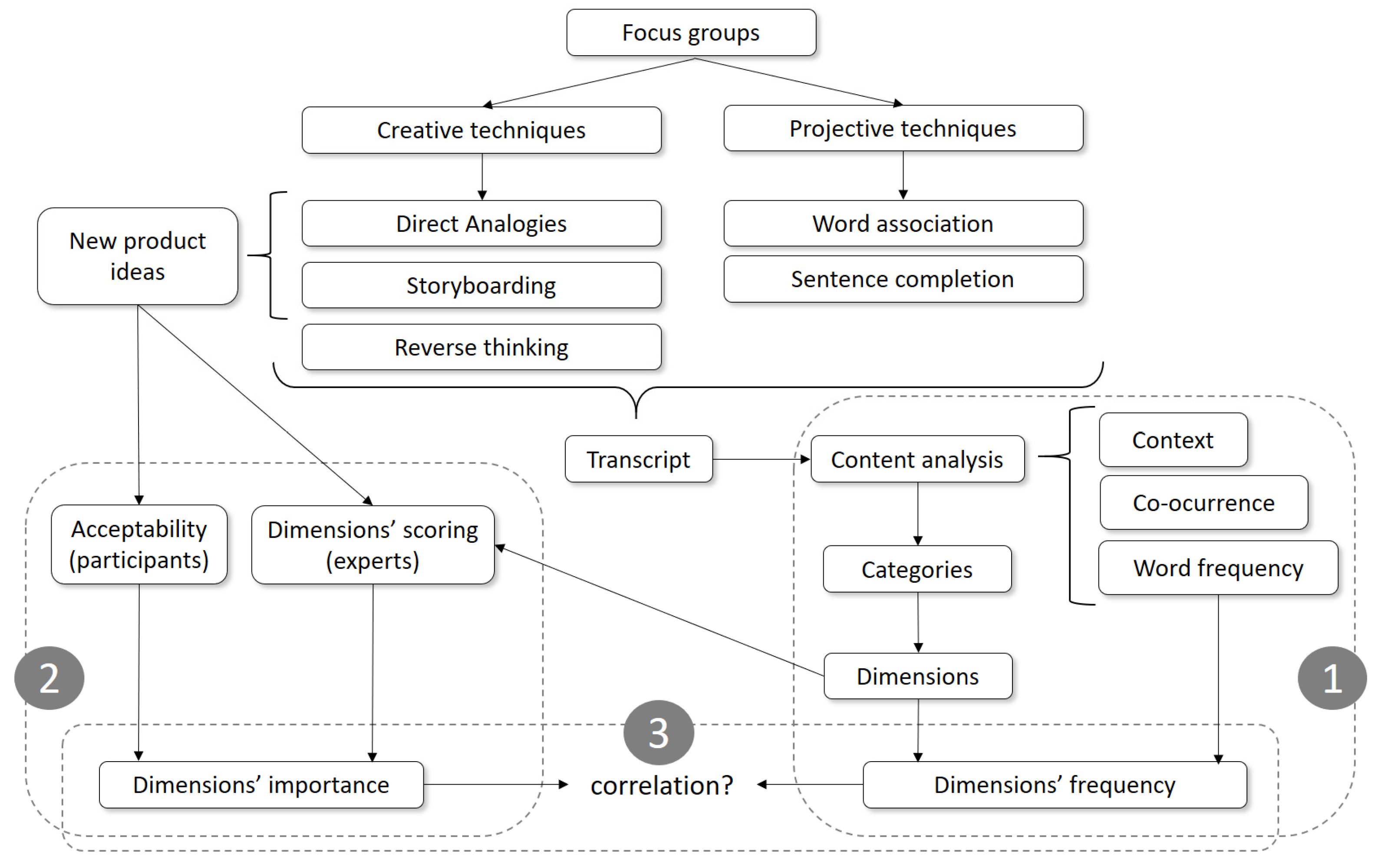
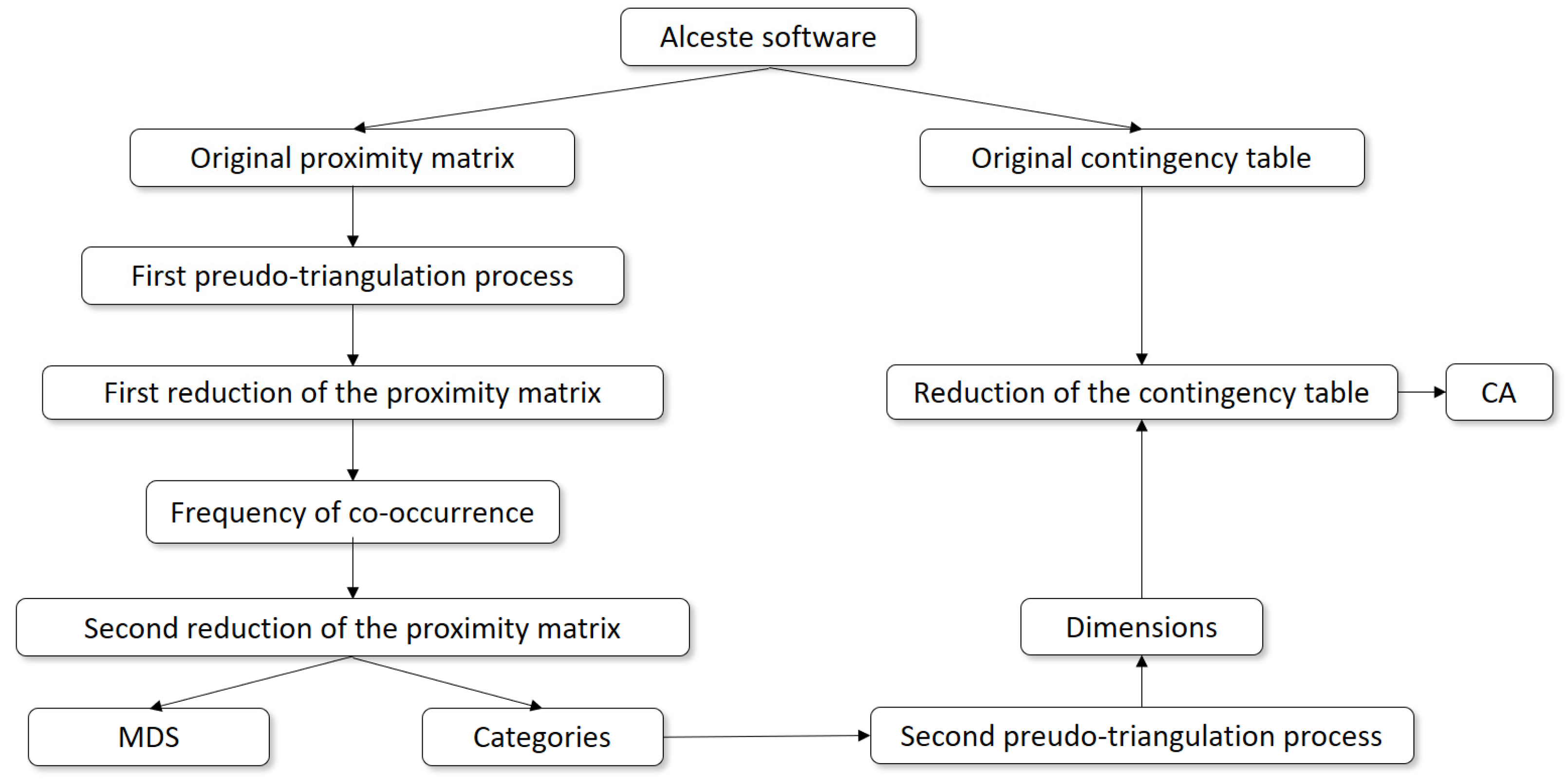
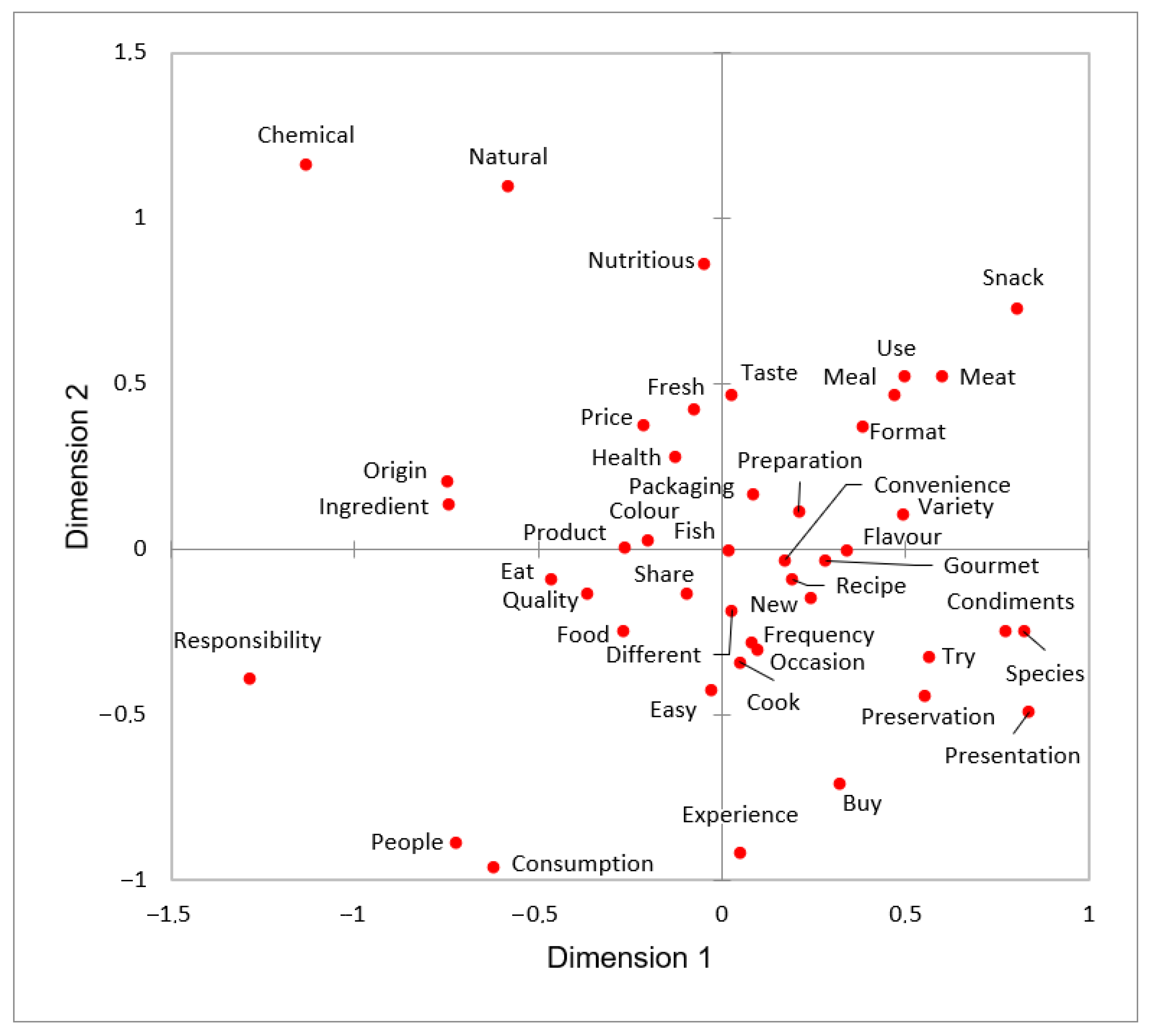
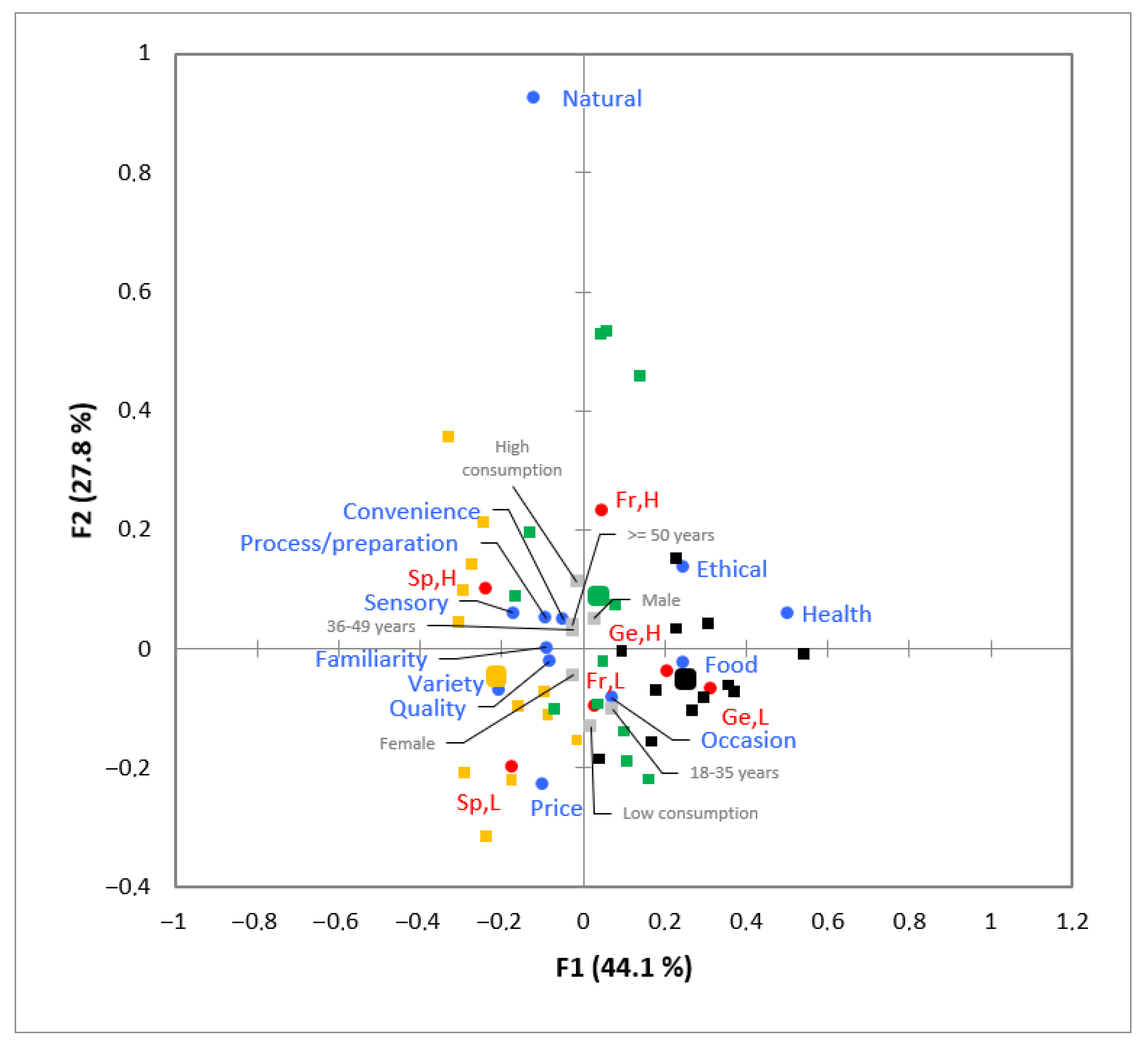
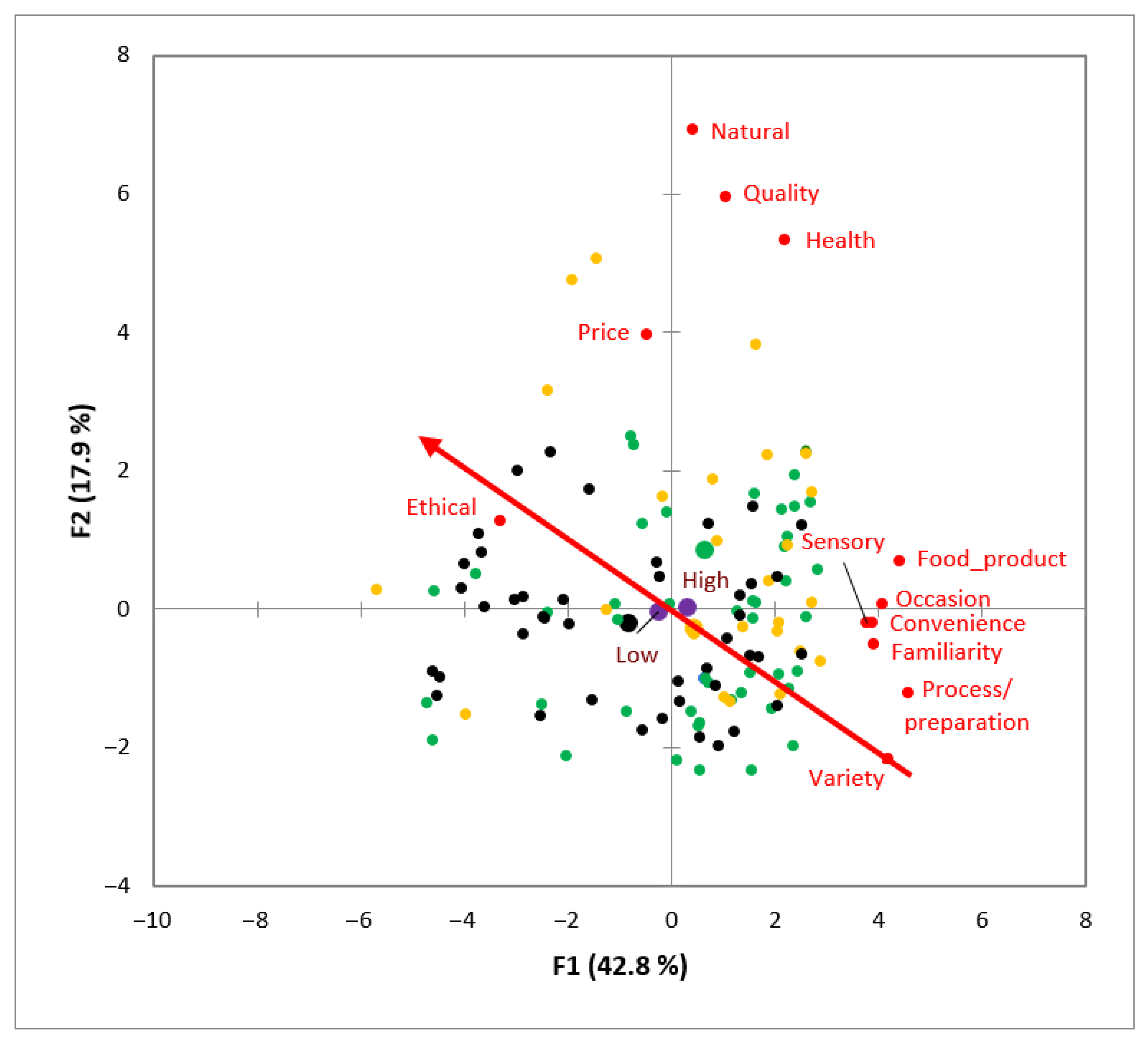
| Experts’ Mean | Acceptability | Dimension’s Importance | |||
|---|---|---|---|---|---|
| Ideas | Sensory | Price | Participant 1 | Sensory | Price |
| Idea 1 | 2 | 6 | 9 | 18 * | 54 |
| Idea 2 | 7 | 4 | 5 | 35 | 20 |
| ∑ | 53 ** | 74 | |||
| Dimension | Categories |
|---|---|
| Health | Health, nutritious |
| Process/preparation | Product, preparation, condiments, cook, ingredient, recipe |
| Sensory | Colour, experience, flavour, gourmet, taste, try |
| Quality | Quality, fresh, origin, preservation |
| Price | Price, buy |
| Familiarity | Frequency, use |
| Natural | Natural, chemical |
| Food_product | Consumption, eat, fish, meat, food, meal |
| Variety | Variety, different, format, new, presentation, species |
| Convenience | Convenience, easy, snack |
| Ethical | Responsibility, packaging |
| Occasion | Occasion, people, share |
Publisher’s Note: MDPI stays neutral with regard to jurisdictional claims in published maps and institutional affiliations. |
© 2022 by the authors. Licensee MDPI, Basel, Switzerland. This article is an open access article distributed under the terms and conditions of the Creative Commons Attribution (CC BY) license (https://creativecommons.org/licenses/by/4.0/).
Share and Cite
López-Mas, L.; Claret, A.; Stancu, V.; Brunsø, K.; Peral, I.; Santa Cruz, E.; Krystallis, A.; Guerrero, L. Making Full Use of Qualitative Data to Generate New Fish Product Ideas through Co-Creation with Consumers: A Methodological Approach. Foods 2022, 11, 2287. https://doi.org/10.3390/foods11152287
López-Mas L, Claret A, Stancu V, Brunsø K, Peral I, Santa Cruz E, Krystallis A, Guerrero L. Making Full Use of Qualitative Data to Generate New Fish Product Ideas through Co-Creation with Consumers: A Methodological Approach. Foods. 2022; 11(15):2287. https://doi.org/10.3390/foods11152287
Chicago/Turabian StyleLópez-Mas, Laura, Anna Claret, Violeta Stancu, Karen Brunsø, Irene Peral, Elena Santa Cruz, Athanasios Krystallis, and Luis Guerrero. 2022. "Making Full Use of Qualitative Data to Generate New Fish Product Ideas through Co-Creation with Consumers: A Methodological Approach" Foods 11, no. 15: 2287. https://doi.org/10.3390/foods11152287
APA StyleLópez-Mas, L., Claret, A., Stancu, V., Brunsø, K., Peral, I., Santa Cruz, E., Krystallis, A., & Guerrero, L. (2022). Making Full Use of Qualitative Data to Generate New Fish Product Ideas through Co-Creation with Consumers: A Methodological Approach. Foods, 11(15), 2287. https://doi.org/10.3390/foods11152287






